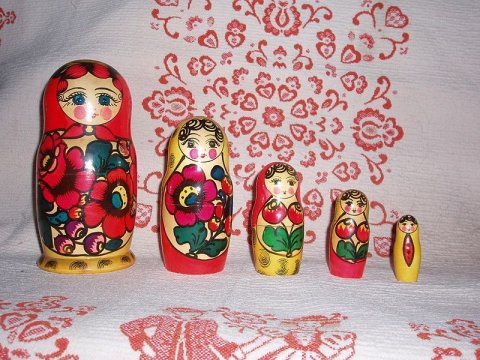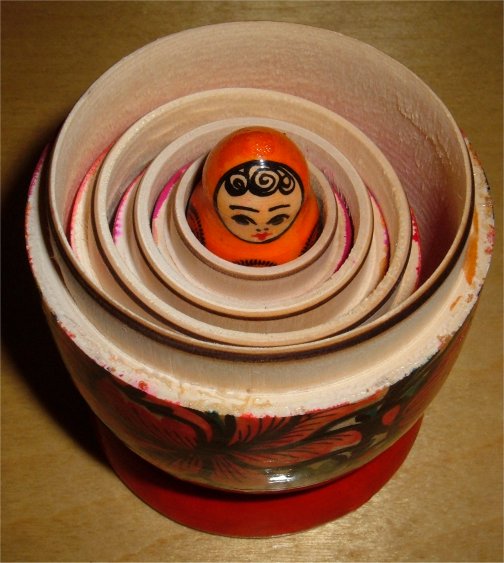Nesting Dolls and Supernovae
Updated June, 2023

Russian Matryoska Dolls By FanghongBy No machine-readable author provided. Fanghong assumed (based on copyright claims). - No machine-readable source provided. CC BY-SA 3.0, https://commons.wikimedia.org/ w/index.php?curid=69399
A matryoshka doll, also known as a Russian nesting doll, is a set of wooden dolls of decreasing size placed one inside another. The name "matryoshka", literally means "little matron", which is a diminutive form of Russian female first name "Matryona" or "Matriosha".https://en.wikipedia.org/wiki/Matryoshka_doll I believe these dolls developed from the Dogon nesting concept of a red giant star, which was associated with the divine feminine in the Dogon religion.
The Dogon believed that the output of the first supernova created from the first red giant star formed the basis of the one that followed it. It then formed the basis for the one that followed it and so on. In this way life in the Universe was constantly regenerating and replicating itself.
In my book The Rose, I describe how these red giant stars became identified with the symbol of the rose in Europe. On these dolls, we see an association with the divine feminine and the symbol of the rose.

Nesting Dolls By BrokenSphereBy BrokenSphere - Own work, CC BY-SA 3.0, https://commons.wikimedia.org/ w/index.php?curid=3773186
This is a set of matryoshkas consisting of a wooden figure, which separates top from bottom to reveal a smaller figure of the same sort inside, which has, in turn, another figure inside of it, and so on. This set reveals the smallest doll in a set of floral-themed matryoshkas nested in the lower halves of the bodies of the larger dolls.
Matryoshka dolls are often referred to as "babushka dolls", babushka meaning "grandmother" or "elderly woman".https://en.wikipedia.org/wiki/Matryoshka_doll
"The first Russian nested doll set was carved in 1890 by Vasily Zvyozdochkin, designed by Sergey Malyutin, who was a folk crafts painter in the Abramtsevo estate of Savva Mamontov .... Malyutin's doll set consisted of eight dolls-the outermost was a girl in a traditional dress holding a rooster. The inner dolls were girls and a boy, and the innermost a baby."https://en.wikipedia.org/wiki/Matryoshka_doll
The rooster is an important symbol in the Dogon religion and associated with the Jackal and the failed experiment. The eight dolls also likely symbolize the Eight Nummo Ancestors.
"Zvyozdochkin and Malyutin were inspired by a doll from Honshu, the main island of Japan." This is important because there are many associations between Celtic Ireland and the ancient Jomon of Japan, which is referred to in Day of the Fish. My research reveals that the Celtic cultures of Europe, the United Kingdom and Ireland are very similar to the Dogon religion and may have even been one in the same religion.
Sources differ in descriptions of the original Russian nesting doll, describing it as either a round, a hollow daruma doll portraying a bald old Buddhist monk, or a Seven Lucky Gods nesting doll."https://en.wikipedia.org/ wiki/Matryoshka_doll
The Daruma's traditional red colouring was thought to have come from the color of priest's robes. Since Daruma was the founder of the Zen Sect, it was concluded that he must have worn a red robe.https://en.wikipedia.org/ wiki/Daruma_doll In the Dogon religion, the red colour was associated with a red giant star (a pregnant Sun) that exploded as a supernova to give birth to the Universe. The Mistress of Speech was associated with the second red giant star and she was known as the Seventh Ancestor.
In Japan, Daruma's facial hair was a symbolic representation of animals known for their longevity including the crane and the tortoise. Originally there was a snake or dragon depicted in the facial hair but this was changed to match the Japanese proverb "The crane lives 1000 years, the tortoise 10,000 years".https://en.wikipedia.org/wiki/Daruma_doll
The reference to the tortoise and snake are important. The tortoise was a symbol of the Sun in the Dogon religion, which was also a symbol of the Nummo, who were described as being snake or serpent like. My research in The Nummo reveals that the dragon became a symbol of the Nummo in China and other cultures. Storks and Cranes also appear in other cultures in association with the Nummo.
In Japan at the end of the year, all the Daruma were brought back to the temple for a traditional ceremony where they were all burnt together. "After a solemn display of the monks' entry, reading of the sutras and blowing of horns, the tens of thousands of figurines are then set aflame."https://en.wikipedia.org/ wiki/Daruma_doll
This is important because when a red giant star expands into space it burns up and absorbs all the stars and planets in its path. The ceremony celebrating the explosion of a red giant star was associated with the blowing of the Hogon's horn in the Dogon religion. It was associated with a supernova explosion and is described in this article on Dogon recursion.
My research in The Rose reveals that red giants stars were the creatrix's of the Universe and originally associated with the divine feminine, which was reversed by later patriarchal cultures. This may have also occurred in Japan. "H. Neill McFarland, Professor of Theology, discusses the feminine representations of Bodhidharma in his article Feminine Motifs in Bodhidharma Symbology in Japan."https://en.wikipedia.org/ wiki/Daruma_doll
In the Dogon culture, various children's games were played to imitate what went on cosmically.
This may have been the same case in Japan.
Daruma Otoshi is a traditional game played with a daruma doll in five pieces, usually in the colors of the rainbow, from top to bottom: head -a man's face, blue, green, yellow, red. The game is played by using a small hammer to hit each of the colored pieces, from bottom to the top, without letting the pieces fall during the game.https://en.wikipedia.org/wiki/Daruma_doll
The Smith's hammer was an important symbol in the Dogon religion. It was in the hammer that all the seeds came down from heaven in the Celestial Granary, which was also the Celestial Smithy. The rainbow was as equally important a symbol and associated with the Nummo and the Sun. The rainbow in this game might be identifying a nebula.
For more information on the Dogon religion refer to my books, The Master (Mistress) of Speech, The Nummo, Day of the Fish and The Rose.